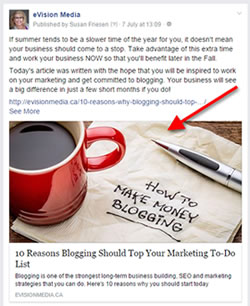In a previous article I wrote about the benefits of blogging and how it can greatly affect your long term business success. Judging by the comments it generated, it looks like my goal was achieved by inspiring entrepreneurs and business owners just like you to put some serious blogging effort into their online marketing efforts.
So now that I have you all fired up to start blogging, there’s a few things that you need to be aware of for those benefits to materialize and get you some raving fans who will happily comment on and share your posts to their followers.
After reading this article, you’ll know what you need to do, and not do, in order to be successful at blogging. When done, leave a comment and let me know about your biggest blogging challenges – did this article help at all?
Here’s 7 tips that will help with your blogging success:
-
Update frequently or don’t bother at all.
There are two reasons to add new posts to your blog on a frequent and consistent basis. The first one is that if someone visits your blog and sees that the last article posted was 6 or more months ago, then their immediate impression will be that you are no longer in business.
Yes, it will be that drastic! They won’t assume that you’re too busy to tend to your blog. What they WILL assume is that you’ve abandoned your website; therefore, your business as well.
The other reason is for SEO (Search Engine Optimization). The more you write and post an article in your blog, the more Google and other search engines will see that you are actively updating your website and will reward you for it.
Over time, you will notice that your articles will get picked up in the search engines quicker and, as long as you are using good keywords that your ideal target market is using in their searches, your article will show up higher in their search results.
How often should you post? Let me put it this way: once a month is better than every 6 months, once a week is better than once a month, every day is better than once a week. You get the idea…
-
Provide substance over quantity.
I recently participated in a Facebook group daily blog challenge where the idea was to motivate members to write a blog post every day. When a new blog is posted, that member must go to the previous two blog posts and add a comment. I think the concept is terrific but when it was my turn to write a comment on other posters’ article, it was a challenge to come up with something to say!
The reason is, many of the times, these articles, if you call them that, were thrown together with, what seemed like, very little thought. It was obvious they were only in place so that the author had something to post for that day. Essentially, they were posting useless crap.
This is not how blogging should be done. The articles that you write must be topical to what your target market wants to learn about. This is why doing your research on who your ideal client is first is critical.
You want to write about things that they will find of interest, of value or find entertaining and captivating. Write for them, not just for the sake of having something posted.
So be sure to write about topics that your target market will find of interest and value. And always have a purpose in mind: what do you want your readers to get out of this and what do you want them to do after reading?
-
Give them a reason to keep coming back.
One of your objectives when blogging is to create a community – a place for people to keep coming back to get more of what you’re offering.
This means your blog posts must be either entertaining, informative, compelling and/or emotionally charged to keep people engaged and wanting to come back for more.
You know you have accomplished this when you get lots of subscribers and lots of comments on each post where your followers are eager to add their two cents worth.
-
Be specific to one thought, idea or topic.
I’m guilty of this. often.
In fact, what you’re reading right now was part of the previous article I wrote on blogging. Luckily I’m getting better at recognizing that I have tried to add too many ideas or topics into my posts and have learned to put my editor’s cap on and break out my “extra” thoughts into articles of their own. I remember one article I wrote not long ago provided me with three separate articles!
The point here is to avoid sharing everything you know all in one article. Instead, pick one specific topic or idea and write about it.
It’s harder than you think because if you’re anything like me, that one specific topic will compel you to explain in more detail an idea you’ve shared and the next thing you know, you’re going down a rabbit hole.
So remember, you can always save those other ideas for your next article like I’ve done many times before.
-
Include at least one large image.
 Images are a must for blog posts. Not only do images help your readers get a visual idea of what the article is about, they also help break up text, emphasize important points, and create more interest than just a long article full of text.
Images are a must for blog posts. Not only do images help your readers get a visual idea of what the article is about, they also help break up text, emphasize important points, and create more interest than just a long article full of text.Each article should have, at minimum, a large image at the top of your post so that it’s sharable to Pinterest.
But it’s not just for Pinterest; many social media channels provide a preview of the blog post that gets displayed and usually, if your blog is set up properly, the image is grabbed and provides something visual when sharing to those other social media channels.
-
Don’t use 3rd party blogging services.
Be sure to have your blog hosted on your own domain where your website is hosted. Do not use 3rd party services like Tumblr or WordPress for your business blog.
Unfortunately, because these services are free and usually easy to set up, they make it very tempting to go that route instead of hiring a web developer to install WordPress and theme it to match the look and feel of the rest of your website.
But using these services negate the whole SEO reason why you want to be blogging in the first place.
Essentially what you are doing is sending people to THEIR services instead of to YOUR website – and that, at the end of the day, is the whole point of blogging! To get people to go back to your website so they can find more about you. If you are just sending them to a 3rd party blog, you’ve missed that boat entirely.
-
Fix the spelling and grammar mistakes.
Honestly, this shouldn’t have to be said by oh my goodness, does it ever need to be said!
I remember once reading someone’s blog post and it was so hard to read due to grammar mistakes that I gave up. The irony is, she was a copywriter! Can you guess what impression her readers have on her ability to write well? Not so great.
Understandably, not everyone has a Masters degree in English. I don’t either and more than likely, if you looked hard enough, you’ll find mistakes in my writings. But that’s not the point here, nor the expectation. What you do want to strive to achieve is something that is readable and not full of obvious mistakes.
If you’re one of those people who have great ideas and lots of information to share but are terrible in the English department, this is the time to hire someone to help you. We do this a lot for our clients – they will send us their rough draft of the newsletter, we’ll edit it, make it look pretty, add it to their blog, SEO optimize the post, and then send out their newsletter that includes the post as well. Easy peasy for the non-writer.
Ok now that you are aware of all the benefits of blogging and what you need to know to make your efforts successful, it’s your turn to get writing!
What are your biggest blogging challenges? Share in the comments section below!
To your business success,
Susan Friesen
P.S. If you liked the article, you might want to subscribe to our newsletter. We publish tons of valuable content to help you learn more about marketing, and subscribing is the best way to ensure you don’t miss out. Additionally, if you’d like to learn more about creating a successful and profitable website, while avoiding costly mistakes, click here for our free report on the 6 Critical Steps to Creating a Successful and Profitable Website.







